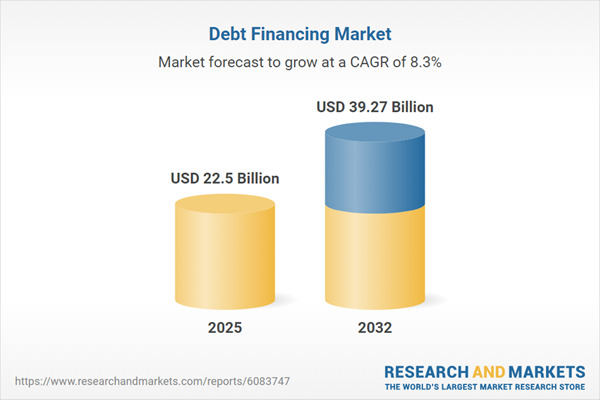Speak directly to the analyst to clarify any post sales queries you may have.
Debt financing is experiencing significant evolution, driven by changing economic conditions, regulatory updates, and new financial technologies. Senior executives must recalibrate strategies to capture opportunities, address risk, and maintain a competitive edge as the market landscape grows more complex and globalized.
Market Snapshot: Debt Financing Market Growth and Outlook
The Debt Financing Market increased from USD 20.79 billion in 2024 to USD 22.50 billion in 2025, and is projected to grow at a compound annual growth rate (CAGR) of 8.26%, reaching USD 39.27 billion by 2032. This upward trend reflects growing demand for structured credit solutions across corporate and individual segments. Digital innovation and expansion of capital markets are encouraging diversification, as both traditional financiers and new entrants respond to shifting borrower requirements and investment strategies.
Scope & Segmentation of the Debt Financing Market
This report presents in-depth analysis and revenue forecasts across a comprehensive range of market segments and dimensions relevant for strategic planning:
- Lender Types: Covers banks, government agencies, non-banking financial companies, peer-to-peer lenders, and private lenders, highlighting unique risk profiles and market reach.
- Collateral Structures: Examines both secured and unsecured lending, providing insight into how collateralization affects risk and pricing for lenders and borrowers.
- Borrower Types: Evaluates corporate, individual, and SME borrowing needs, enabling targeted product strategies and risk segmentation.
- Interest Rate Structures: Details offerings with fixed and floating rate terms, supporting flexible structuring of facilities based on market expectations.
- Loan Purposes: Covers capital expenditure needs such as equipment and real estate financing, M&A activities including leveraged buyouts and acquisition financing, strategies for asset refinancing and debt consolidation, and working capital requirements like inventory and receivables financing.
- Loan Maturities: Assesses long term, medium term, and short term loans, aligning products with repayment capabilities and funding horizons.
- Ticket Sizes: Analyzes large, medium, and small loans to guide portfolio diversification and deal structure.
- Industry Verticals: Provides sector-specific analysis, spanning healthcare (including hospital services, medical devices, pharma), infrastructure (energy, transportation, utilities), IT & telecom (hardware, software, telecom services), manufacturing (automotive, chemicals, electronics), real estate (commercial, industrial, residential), and retail (brick and mortar, ecommerce).
- Geographic Regions: Includes the Americas (North America and Latin America), Europe, Middle East, Africa, and Asia-Pacific, with additional country-level insight for tailored market entry and strategy.
- Key Companies Covered: Profiles leading players such as JPMorgan Chase & Co., Citigroup Inc., Bank of America Corporation, Barclays PLC, The Goldman Sachs Group, Inc., Morgan Stanley, Mitsubishi UFJ Financial Group, Inc., BNP Paribas S.A., HSBC Holdings plc, and Deutsche Bank Aktiengesellschaft.
Key Takeaways for Senior Decision-Makers
- Digitalization and AI are transforming credit origination and risk management, enabling lenders to streamline underwriting and improve decision accuracy.
- ESG factors are increasingly central in lending, influencing how loans are priced and which borrowers attract capital.
- The growth of non-bank and alternative lending channels is broadening the scope of financing, introducing more competition and expanding access beyond traditional banking institutions.
- Segment-specific strategies are critical. Large corporates are focusing on bespoke solutions for M&A and refinancing, while SMEs and individuals prioritize adaptable, modular lending products.
- Regulatory harmonization and regional policy changes are changing how organizations address compliance, risk management, and asset allocation, accelerating portfolio updates in response to evolving requirements.
Tariff Impact: Navigating New U.S. Measures
The introduction of 2025 U.S. tariff measures has prompted lenders to adopt more stringent underwriting standards and implement new loan covenants, particularly for borrowers with extensive global supply chains. Companies reassess cross-border capital flows, adjusting funding structures to address increased volatility and variable input costs. These shifts are driving re-examination of both location-based risks and long-term financing models for multinational organizations.
Methodology & Data Sources in the Debt Financing Market Report
The analysis integrates primary research including interviews with senior banking, finance company, and regulatory executives, complemented by secondary data from filings, proprietary databases, and industry publications. Both quantitative and qualitative techniques are used to deliver accurate, actionable analytics.
Why This Report Matters for Strategic Leadership
- Provides senior decision-makers with tailored competitive intelligence, supporting informed market entry and positioning decisions in debt financing.
- Delivers practical insights for optimizing capital structures, enhancing risk frameworks, and staying ahead of regulatory developments.
- Empowers leaders to benchmark against industry innovators, drive effective technology adoption, and pursue sustainable finance strategies.
Staying current with market evolution, technology shifts, and regulatory dynamics is essential for guiding organizations in a rapidly changing debt financing environment.
Conclusion
The debt financing sector is adapting to ongoing economic, technological, and policy changes. Leaders who prioritize targeted analysis and agile strategy will be equipped to make robust, future-oriented decisions.
Table of Contents
3. Executive Summary
4. Market Overview
7. Cumulative Impact of Artificial Intelligence 2025
Companies Mentioned
The companies profiled in this Debt Financing market report include:- JPMorgan Chase & Co.
- Citigroup Inc.
- Bank of America Corporation
- Barclays PLC
- The Goldman Sachs Group, Inc.
- Morgan Stanley
- Mitsubishi UFJ Financial Group, Inc.
- BNP Paribas S.A.
- HSBC Holdings plc
- Deutsche Bank Aktiengesellschaft
Table Information
| Report Attribute | Details |
|---|---|
| No. of Pages | 187 |
| Published | October 2025 |
| Forecast Period | 2025 - 2032 |
| Estimated Market Value ( USD | $ 22.5 Billion |
| Forecasted Market Value ( USD | $ 39.27 Billion |
| Compound Annual Growth Rate | 8.2% |
| Regions Covered | Global |
| No. of Companies Mentioned | 11 |









